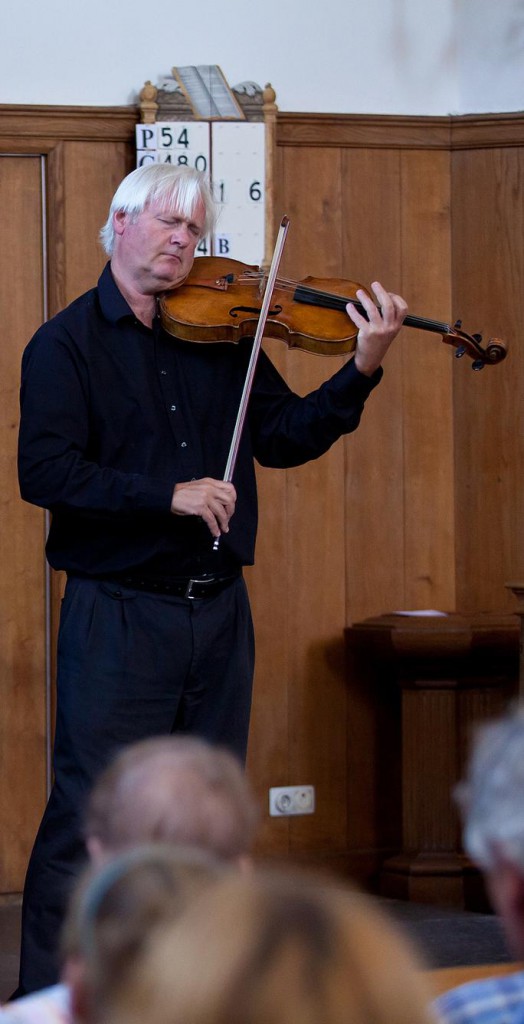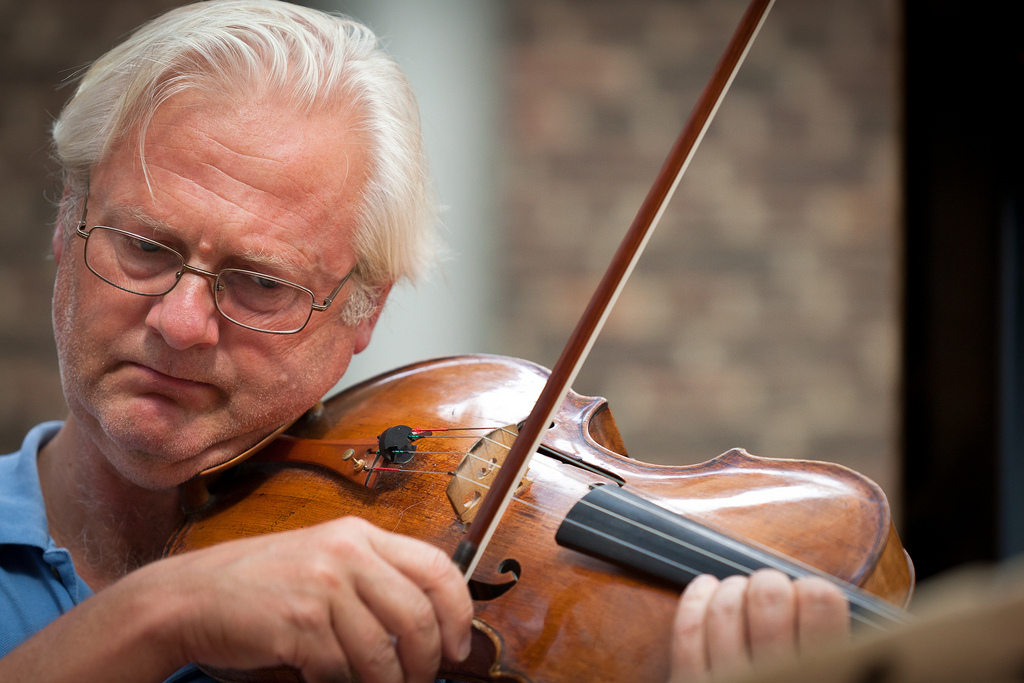“The viola has a Mona Lisa duality, both joyful and melancholy at the same time.”
The “Norwegian Giant” Lars Anders Tomter is widely regarded as a world class violist. Last month he played at the Delft Chamber Music Festival, and the DVS was lucky to find mr. Tomter prepared for a chat about the festival, his role as a violist and the development of viola repertoire.

Lars Anders Tomter performing during the Delft Chamber Music Festival 2013. Published with permission from DCMF / (c) Ronald Knapp
DVS: You have been coming to the festival in Delft for quite a few years now, haven’t you?
Yes, this must be at least the fourth time.
DVS: What sets the Delft Chamber Music Festival apart from other festivals?
Every festival has its own character, and Delft has a lot of it. For one thing it is due to the very special location, a town which is worth the trip regardless. Secondly due to Liza [Ferschtman, artistic manager], whom I value highly, a fantastic musician and a wonderful person. Easy to get along with, clear but flexible, both in her musicianship and in her general demeanour. So it’s both the place, with its audience, and the artistic leadership.
DVS: Liza Ferschtman explains that she consciously invites individual musicians rather than fixed ensembles to this festival. As a consequence, the programming features many pieces from the fringes of the chamber music repertoire, with unusual casts such as quintets and sextets. Does this agree with your own preferences?
That’s indeed the key idea. I also run a festival like this, in Risør [Norway]. Such a festival is a bit like a family gathering, even if you don’t actually know all the other players beforehand. An orchestra is a state, a chamber ensemble is a family. And it is always interesting to see which combinations of musical and human personalities will give sparks.
The string quartet is actually a singularity, with a huge repertoire, and a highly developed sense of perfection. Therefore the string quartet repertoire has been more or less conceded entirely to the domain of professional quartets. Perfection in itself is of course a good thing, but there is a risk that the playing becomes predictable when one has worked together for 30-odd years. On the other hand, when players do not know each other so well, the result could be less predictable, in a good sense.
So a festival like this is a golden opportunity to pick up the non-quartet chamber repertoire. Some of these works are true pearls, and in certain special cases they can surpass the same composer’s string quartets. For example, the Brahms piano quartets and quintets, as well as his string sextets, are at least as good as his string quartets. Don’t get me wrong, I really like the Brahms quartets, they are very good – especially the 3rd quartet with the viola solo, haha. I also want to mention the Mozart (viola) quintets, they are a special treasure. And the Schubert (cello) quintet, of course.
And then there is the piano trio, also with a considerable standard repertoire. But this combination of instruments is not so homogeneous, so the advantage of a fixed partnership is less obvious, and it is a bit easier to put together a decent piano trio from three good individuals.
DVS: So, within the context of such an ad-hoc festival ensemble, do you sense a special role for the viola player?
I’m sure there is! But I’m so used to this role, I have little reference for comparison to the other instruments. I did play the violin quite a lot in the past, but it was almost always viola for chamber music.
I simply love the sound of the viola, it has something eternally attractive to it. It’s got a Mona Lisa duality, both joyful and melancholy at the same time. That ambiguity fascinates me, and it is very well suited to the music of Mozart and Brahms. Those two particular composers certainly knew how to employ the viola in their music, and that is no coincidence.
A cello often plays high in its own register, like an operatic tenor, showing off. The viola is drawn to the deep end of its own register, it is more introverted, its base character embodies ambiguity and tenderness.
DVS: But your own viola is definitely not of the modest kind… how did you find it?
I had spread the rumour that I was looking for something grand. I had my mind set on an original Brescian instrument, preferably one of the “nameless” (and hence affordable) ones. But then I came across this one, a Gasparo di Salo from 1590. So it had a name, and a price. There was a long and exhausting search for a private sponsor who would help me to get this viola, but at long last I was fortunate to get help from Selvaag (a major Norwegian enterpeneuring company, red.).
DVS: So you were very determined to have this instrument?
This was exactly what I was looking for. It is a big instrument (44.5cm), which suits me physically. Such a size gives you something extra, it has all I could wish for in a viola: Depth, power, sonority, and evenness in range. Oftentimes in a viola you have to choose between depth and high range, but this instrument has both, it doesn’t choke. It is a very complete viola, the best I’ve ever experienced.
DVS: Is there an explanation for the remarkable increase in the number of internationally renowned violists in general, and from Norway in particular?
The overall level of viola playing has improved a lot in the last decades. Some pioneers have acquired technical skills far beyond what had previously been thought possible for a violist. In their time, Tertis and Primrose set new standards for viola technique. The virtuosity attained by Primrose is probably unsurpassed to this day, he was in a way the Heifetz of the viola. I must also mention Peter Schidlof from the Amadeus Quartet, a unique violist with a voice that I never tire of listening to.
In modern times we see a considerable number of viola soloist careers: Nobuko Imai, Kashkashian, Bashmet, Tabea Zimmermann, and many others.
In the last decade we have also seen an improving level of viola playing in Norway, and a few artists have actually made themselves noticed. Those successful musicians spring from a solid culture of string teaching. Names such as Eivind Ringstad, Ellen Nisbeth and Ida Bryhn. Oslo Philharmonic lead Catherine Bullock is an example of excellent musicians drawn from abroad, strengthening the viola community in Norway.
DVS: Who was most influential in your musical development?
I’d have to mention all of my teachers, mostly violinists. I started out in Hamar with the violin teacher Michael Oustad, a wonderful guy, who was great at teaching children, that’s very important. Next I came to Leif Jørgensen, it was with him that I started playing the viola. I made my debut recital in the Aula (an Oslo concert hall, red.) when I was 17, mostly a violin programme, but also one piece on the viola. Later on I continued my studies with Max Rostal.
After this I went back home for a few years, during which Leif Jørgensen helped me to a teaching position at Godlia (Østlandets Musikk-konservatorium). I was then asked to play the Bartok concerto with the Bergen Philharmonic. I was about 20-21 years, I had never before played a viola solo concerto, I had barely even heard the piece, but I accepted the challenge and went to buy the sheet music. At least I had almost a year to prepare for it. During this time I also got involved in a string quartet, and entered some competitions. I ended up studying with Sándor Vegh for 2 years, and from then on I only played the viola.
In terms of influences, I learned something from all of the good players I met. Technically I feel that violin and viola are fundamentally the same, I can do both quite easily. But nevertheless I’m very much a violist – the viola is “my” voice, just like every singer has a voice of his own.
DVS: We talked about the viola repertoire earlier. You have arranged several pieces for viola yourself, for example “Fratres” by Arvo Pärt. How do you approach the adaptation of repertoire from other instruments?
You have to be critical, it is very much a case-by-case consideration. The “Fratres” transcription was in fact approved by Pärt himself. This piece is a bit of a special case, because there are already so many transcriptions. But there was a violin and a cello version to work from, and that made it even easier.
I have also recorded the César Franck sonata for viola, which also already existed for violin and cello – that makes it a natural choice. And the Grieg cello sonata, which works very well on viola, maybe even better than the original.
As for concerto repertoire, I have recorded the Bach double concerto for violin and oboe (BWV 1060, red.) for viola and bassoon, and the Mozart clarinet concerto for viola, which was transcribed shortly after Mozart’s death (1802). The latter recording (Simax, Norwegian Chamber Orchestra) also features a viola quintet version of Mozart’s famous clarinet quintet.
DVS: There are many examples of the connection between the viola and clarinet. Not only do they share some repertoire (e.g. the Brahms sonatas) but they also regularly appear together, for example in trios with a piano (Mozart’s Kegelstatt, Bruch’s Eight pieces).
Yes, I suppose this is because they have roughly the same range. The Brahms sonatas were produced in both clarinet and viola versions from the start.
DVS: It looks like there’s a steady increase in the production of new works for the viola, both as a solo instrument and in chamber ensembles. Is the viola becoming a favourite instrument for contemporary composers?
It is true, and there are two clear reasons: One, there are more strong viola soloists around commissioning new works. I’ve done so myself. And secondly it is exciting for a composer to write for an instrument that still has unexplored possibilities. And at any rate, the viola has many more options for sound production than most wind instruments. It is matched by the violin and cello in this respect, but as a solo instrument, the viola has been standing in their shadow until recently.
DVS: Would it be appropriate to speak of a viola renaissance?
Yes, if you like.
DVS: And then the inevitable question: Do you think there will ever be a Norwegian Viola Society? Now that we have established a first cooperation with Eivind Ringstad’s recital at our congress in September, it would be very useful to keep this connection alive with some structure in Norway.
That is a very good idea. I have in fact tried to encourage some of my colleagues to start such a thing, unfortunately I have no time myself.
© 2013 Dutch Viola Society / edited by Kristofer G. Skaug

